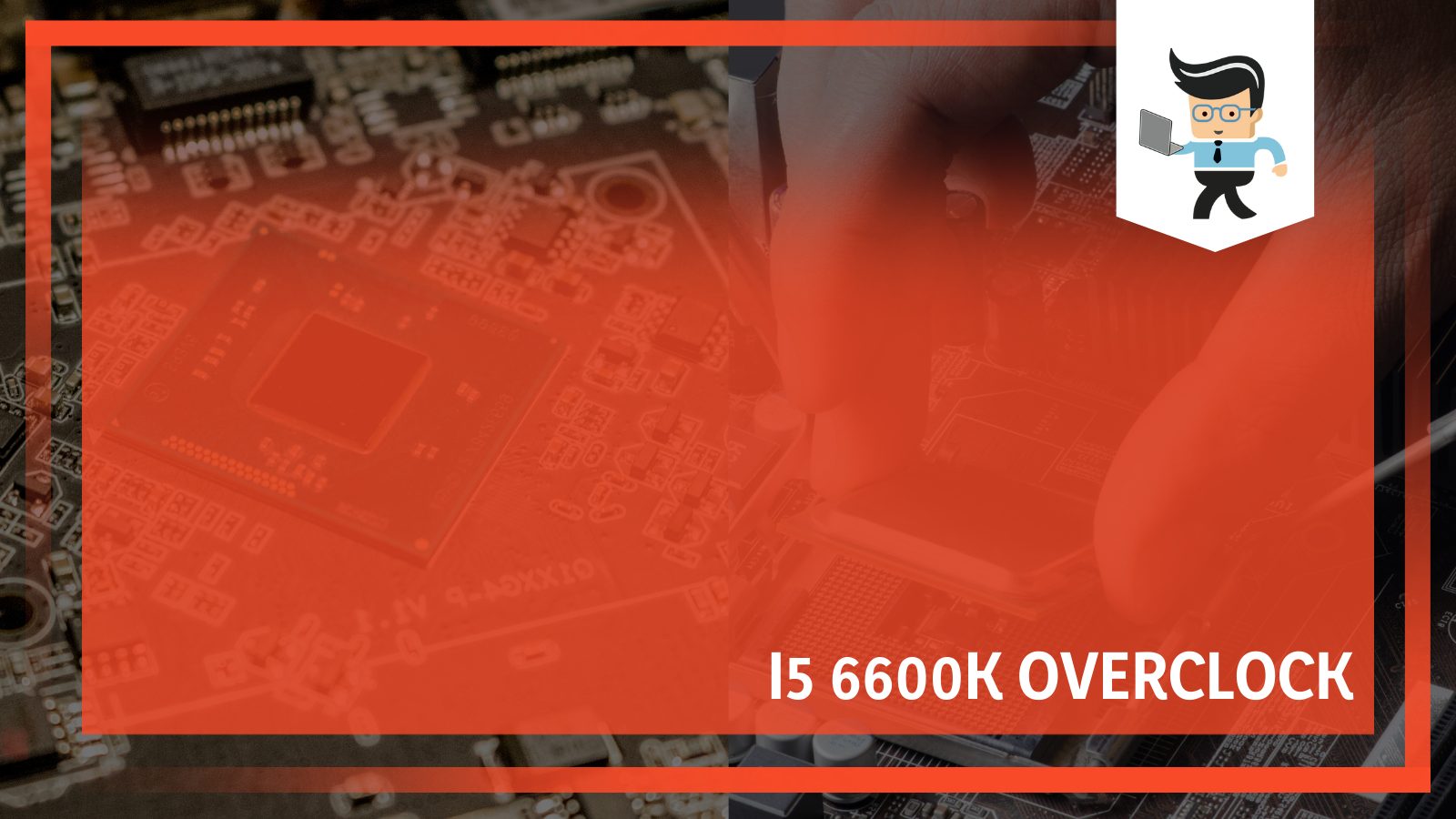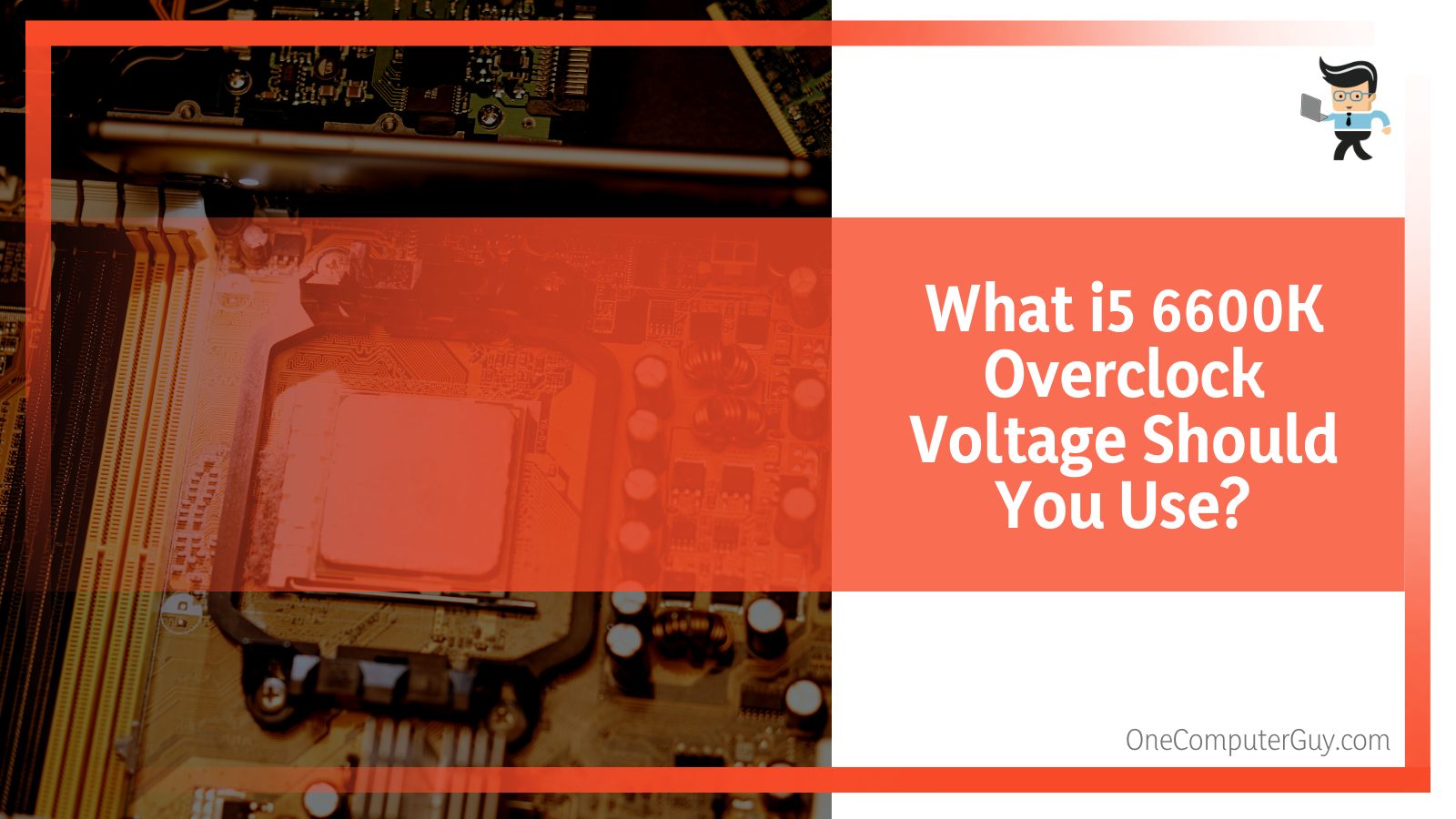Performing an i5 6600K overclock can take the processor from its stock maximum speed of 3.9 GHz to 4.6GHz and a maximum performance gain of up to 8.5%.

Even though the processor can handle demanding CPU-bound games and tasks like video editing quite well, overclocking it using the right equipment can help you get the maximum use out of your CPU.
If you’re still on the fence about overclocking the i5 6600K, read further to learn everything you should know.
Contents
- Can You Overclock an i5 6600K?
- Why Should You Overclock an i5 6600K?
- How Far Can You Overclock the i5 6600K?
- What i5 6600K Overclock Voltage Should You Use?
- What Components Do You Need to Overclock an i5 6600K?
- What Performance Increase Can You Expect From Overclocking an i5 6600K?
- What Is the i5 6600K Overclock Benchmark?
- Conclusion
Can You Overclock an i5 6600K?
Yes, you can overclock an i5 6600K and change the default multiplier from 35 to up to 46 or even 48, depending on how much your system can handle. Keep in mind that you’ll have to increase the voltage too.
Why Should You Overclock an i5 6600K?
Whether or not you should overclock your Intel Core i5 6600k depends on what use you want from it. The 6th gen 3.5 GHz processor is built on the Skylake architecture, which, with the Turbo Boost 2.0 technology, allows the processor to achieve a maximum clock rate of 3.9 GHz.
As a result, your processor can handle most tasks apart from some intensive ones like video editing or render on Blender.
Overclocking can especially help with bottlenecks, but you’ll need to experiment to find the most stable, maximum overclock speed. Anything beyond that will just make your system unstable, and it might not be able to boot at all if the voltage or multiplier is too high.
But unless you have a graphics card that can benefit from a boost in clock speed, overclocking really won’t make much of a difference. Considering the clock speed and the turbo clock, you don’t really need to overclock if you have a GPU up to an RX 590 or a GTX 1660.
However, if you have an RX 2060 or a GTX 1070 Ti, then you can really benefit from the unhindered performance of an overclocked i5 6600k. As a result, you will be able to notice a substantial difference, especially in the gaming performance – you’ll be able to jump between 1440p and 1080p seamlessly and stay above 60fps in most cases.
Just make sure you have a CPU cooler that can handle all the extra heat that will be generated.
How Far Can You Overclock the i5 6600K?
- Make sure your UEFI/BIOS is up-to-date.
- Set both the RAM and the cache ratio to stock and avoid using XMP profiles. It’s best to just switch off your GPU’s overclock to make things easier for yourself.
- Skylake CPUs can generally handle a clock speed of 4.4 GHz at 1.35V. If it’s not stable at this point, apply a voltage of 1.4V, and you should be fine.
- Now, increase the multiplier and up the voltage if your system crashes when stress testing with an x264 test. The maximum recommended voltage is 1.45v. Plus, you should keep in mind that you shouldn’t do a stress test and just leave the system without keeping an eye on the temperature for the very first two minutes.
- By repeating the steps, you can find the maximum overclock that your CPU can handle without breaking 1.45v. The CPU should also be able to pass the overnight x264 test.
– Tips To Keep In Mind When Overclocking
When overclocking an i5 6600k, you should keep in mind the following:
- Try to change as few settings as you can. If you end up crashing with GPU, RAM, core, and cache overclock enabled, you will have a hard time figuring out which overclock was responsible for the crash.
- Make a point to increase the multiplier by just one each time. This will help you figure out the highest overclock without causing a crash.
- When you increase the multiplier, you will have to increase the voltage every time to stabilize the system.
- It’s better to do things systemically and write down the settings you’ve already tried to stay organized.
What i5 6600K Overclock Voltage Should You Use?
Intel has put the maximum vcore at 1.5v, but generally, the safest maximum is considered to be 1.4V.

When increasing the multiplier from 35 to something higher, you can leave all the voltage on auto and stress-test the system using OCCT or some other similar program. Once you reach the maximum limits, implement SpeedStep. Doing so will bring down the multiplier and Vcore when the processor isn’t stressed.
With the voltages on auto and the multiplier at the max, your motherboard will raise the vcore automatically.
However, you can also set different, higher voltages and get better results but only do so if you know what you’re doing.
What Components Do You Need to Overclock an i5 6600K?
You will not be able to overclock your i5 6600k if you don’t have the proper setup. The following is a list of things you should have:
– Motherboard and RAM
The most important thing you need is a motherboard that supports overclocking. The Skylake Z170 chipset is also necessary since it’s the only chipset at present that allows core clock multiplier overclocking in Skylake processors. While there are a number of Z170 motherboards currently available on the market, for an i5 6600k overclock, MSI Z170a is recommended.
Sixteen gigabytes of DDR4 RAM should be enough to overclock this CPU.
– A Decent Cooling System
When it comes to performing an i5 6600k overclock, stock coolers aren’t sufficient. You will have to invest in an efficient cooling system if you’re serious about juicing your system as much as possible. Even though the 14nm Skylake processor runs cool, you need something good as the CM Hyper 212 or the Cryorig H7.
– A GPU
Choose a GPU that promises incredible performance at a reasonable price. Some good options include the Nvidia GTX 970, 1070, or 1080.
– PSU
Finally, you need a power supply unit that can easily handle all of these components without damaging anything.
What Performance Increase Can You Expect From Overclocking an i5 6600K?
The performance boost depends on how much you overclock your CPU. If you set your processor to run at 4.2 GHz at a voltage of around 1.25-1.26V, you can get a boost of up to 7%.
However, you might not find this to be too much if you’re serious about overclocking. This is particularly because nearly all i5 6600k processors can run on 4.2GHz without really tweaking the voltage or worrying about damaging them.

However, with a powerful setup with all the components listed above, you can raise the multiplier to 46 to get the most benefits and increase the voltage to 1.35v to prevent the system from crashing.
This will give you a better performance boost, but if you really want to test your processor’s limits, you can set the multiplier to more than 47 if you have the right setup. With these settings, you can enjoy more than a 10% increase in performance.
What Is the i5 6600K Overclock Benchmark?
Once you get the highest overclock, we recommend doing some gaming benchmarks to ensure everything works properly. According to different tests and benchmarks, you should be easily able to run intensive games like Battlefield 4, The Witcher 3, and Metal Gear Solid V with the ultra settings on 1080p with a constant 60 FPS. You might even be able to run it on 1440p if you have a good-enough build.
Conclusion
You now know the basics of overclocking an i5 6600k. Here’s a quick overview of all that we’ve talked about:
- The default multiplier of the i5 6600k is 35, but you can increase it to 42 and even more than that with the right setup. Some people can get it up to 48, too.
- Whenever you increase the multiplier, don’t forget to increase the voltage, too. So, for instance, a 6600k running at 4.2 GHz will need a voltage of around 1.25-1.26V.
- Each chip is different, and you will need to experiment a bit to find the highest stable overclock speed.
- To do so, you will have to increase the multiplier and voltage by a small amount and stress test it for stability. If the system is stable, increase both parameters and test again. Keep doing so until you find the highest stable value.
Don’t forget that your build plays a big role in how much you can overclock your processor. This means you shouldn’t test your system beyond its limits unless you have a very good build with top-of-the-line components. And finally, don’t forget to monitor the core temperatures, especially since overclocking produces quite a lot of heat. So make sure you don’t exceed the safe operating, and you’ll be good to go.







